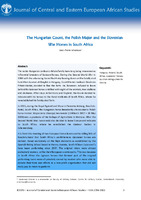The Hungarian Count, the Polish Major and the Slovenian War Horses in South Africa

Megtekintés/
Metaadat
Teljes megjelenítés
Link a dokumentumra való hivatkozáshoz:
Gyűjtemény
Absztrakt
The noble Hungarian Jankovics-Bésán family have long being renowned as influential breeders of Lipizzan horses. During the Second World War in 1944 with the advancing Soviet Red Army bearing down on the family stud farm then located at Oreglak in Hungary, Count Elemér Janković-Bésán de Pribér-Vuchin, decided to flee the farm. He, however, refused to leave behind his beloved horses and fled with eight of the animals, two stallions and six mares. After stops in Germany and England, the Count decided to relocate with his horses to the Natal midlands of South Africa, where he re-established his family stud farm.
In 1951, during the Royal Agricultural Show in Pietermaritzburg, KwaZulu-Natal, South Africa, the Hungarian horse breeder by chance met a Polish horse trainer. Major Jerzy (George) Iwanowski (13 March 1907 – 28 May 2008) was a graduate of the College of Agriculture in Warsaw. After the Second World War, Iwanowski also decided to leave Europe and relocate to South Africa, where he established the Centaur Stables in Johannesburg.
It is from this meeting of two European horse lovers on the rolling hills of KwaZulu-Natal that South Africa’s world-famous Lipizzaner horses are derived. Based exclusively on the high standards as established by the Spanish Riding School based in Vienna, Austria, South African Lipizzaner’s have been performing since 1957. The original riders were almost exclusively women, unlike their European counterparts. This was because in South Africa the Lipizzan horses that formed part of the original performing team were all privately owned by women who were able to donate their time and efforts to a non-profit organisation that did not really pay its riders to perform.
- Cím és alcím
- The Hungarian Count, the Polish Major and the Slovenian War Horses in South Africa
- Szerző
- Scherman, Jean-Pierre
- Megjelenés ideje
- 2023-02-15
- Hozzáférés szintje
- Open access
- ISSN, e-ISSN
- 2786-1902
- Nyelv
- en
- Terjedelem
- p. 3-23.
- Tárgyszó
- Hungary, Poland, South Africa, Lipizzaner horses, Austrian riding school in Vienna, book review
- Változat
- Kiadói változat
- Egyéb azonosítók
- DOI: 10.59569/jceeas.2022.2.3.75
- A cikket/könyvrészletet tartalmazó dokumentum címe
- Journal of Central and Eastern European African Studies
- A forrás folyóirat éve
- 2022
- A forrás folyóirat évfolyama
- 2. évf.
- A forrás folyóirat száma
- 3. sz.
- Műfaj
- Tudományos cikk
- Tudományterület
- Társadalomtudományok - regionális tudományok
- Egyetem
- Óbudai Egyetem
- Kar
- Bánki Donát Gépész és Biztonságtechnikai Mérnöki Kar
